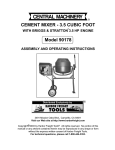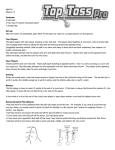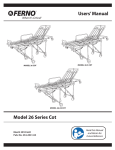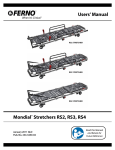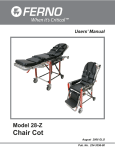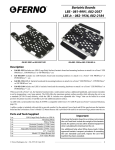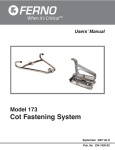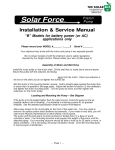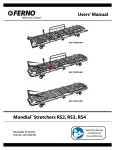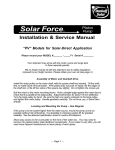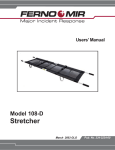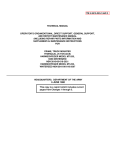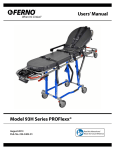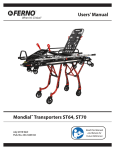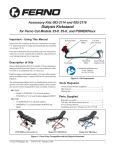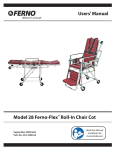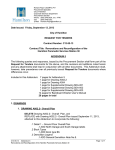Download Ferno 93-ES Squad Mate Ambulance Cot Series User Manual
Transcript
Users’ Manual Model 93ES Model 93ESST Squadmate™ Ambulance Cots April, 2001 Pub. No. 234-2156-00 Models 93ES and 93ESST SquadmateTM Disclaimer This manual contains general instructions for the use, operation and care of this product. The instructions are not all-inclusive. Safe and proper use of this product is solely at the discretion of the user. Safety information is included as a service to the user. All other safety measures taken by the user should be within and under consideration of applicable regulations. It is recommended that training on the proper use of this product be provided before using this product in an actual situation. Retain this manual for future reference. Include it with the product in the event of transfer to new users. Additional free copies are available upon request from Customer Service. Proprietary Notice The information disclosed in this manual is the property of FernoWashington, Inc., Wilmington, Ohio, USA. Ferno-Washington, Inc. reserves all patent rights, proprietary design rights, manufacturing rights, reproduction use rights, and sales use rights thereto, and to any article disclosed therein except to the extent those rights are expressly granted to others or where not applicable to vendor proprietary parts. Additional Instructional Material Provided with the 93ES and 93ESST Squadmate™ Ambulance Cots Video 283-0207 EMT: Injury Free lifting and safety manual 234-1250 © Copyright Ferno-Washington, Inc. All Rights Reserved. Ferno-Washington, Inc. 70 Weil Way Wilmington, OH 45177-9371 U.S.A. Telephone (U.S.A. and Canada) .......... 800.733.3766 Telephone (Worldwide) ....................... 937.382.1451 Fax (United States) .............................. 937.382.1191 Fax (Outside U.S.A.) ........................... 937.382.6569 Internet ............................................. www.ferno.com 2 © Ferno-Washington, Inc. 234-2156-00 April, 2001 Models 93ES and 93ESST SquadmateTM TABLE OF CONTENTS Section Page 1 - Safety Information ............................................................................... 4 2 - Operator Skills and Training ............................................................... 6 3 - About the Cot ...................................................................................... 7 4 - Cot Features....................................................................................... 10 5 - Using the Cot ..................................................................................... 14 6 - Loading/Unloading the 93ES with Antler and Rail Fastener ............ 21 7 - Loading/Unloading the 93ESST with Stat Trac® Fastener ................ 24 8 - Maintaining the Cot ........................................................................... 27 9 - Accessories ........................................................................................ 29 10 - Parts and Service ............................................................................. 30 11 - Limited Warranty ............................................................................ 34 12 - Ferno Customer Service .................................................................. 34 Training Record ...................................................................................... 35 Maintenance Record ............................................................................... 35 Illustrations Safety Labels .................................................................... 5 Height and Strength Considerations ................................. 6 Components ...................................................................... 8 Cot Positions .................................................................... 9 Figure 1 - Supporting the Cot While Squeezing a Control Handle ............................................ 10 Figure 2 - Disengaging the Auxiliary Lock .................... 11 Figure 3 - Lowering the Drop Frame ............................. 11 Figure 4 - Raising the Backrest from Level to the First Position ....................................... 12 Figure 5 - Adjusting the Backrest ................................... 12 Figure 16 - Folding an Empty Cot ................................. 17 Figure 17 - Preparing to Transfer the Patient ................. 18 Figure 18 - Rolling the Cot ............................................ 19 Using Additional Help .................................................... 20 Figure 19 - Examples of Antler and Rail Fasteners ....... 21 Figure 20 - Loading Wheels on Patient Compartment Floor ......................... 22 Figure 21 - Loading the Cot (Antler and Rail) ............... 22 Figure 22 - Unloading the Cot (Antler and Rail) ........... 23 Figure 23 - Stat Trac® Fastener ...................................... 24 Figure 24 - Loading Wheels on Figure 6 - Lowering the Sidearm ................................... 12 Figure 7 - Raising the Shock Frame ............................... 13 Figure 8 - Lowering the Shock Frame ........................... 13 Figure 9 - Unfolding the Lead Handle .......................... 13 Figure 10-A - Model 417-1 Chest/Waist Restraint ........ 14 Figure 10-B - Model 430 Hip and Leg Restraints ......... 14 Figure 11-A - Folded Position ........................................ 15 Figure 11-B - Loading Position ...................................... 15 Figure 12 - Loading to High-Level Rolling ................... 16 Figure 13 - High Level to Mid- or Low-Level Rolling .. 17 Figure 14 - Mid-Level to Low-Level ............................. 17 Figure 15 - Unfolding an Empty Cot ............................. 17 Patient Compartment Floor ......................... 25 Figure 25 - Loading Post Aligned for Loading .............. 25 Figure 26 - Loading the Cot (Stat Trac) ......................... 25 Figure 27 - Pulling the Stat Trac Release Handle .......... 26 Figure 28 - Unloading the Cot (Stat Trac) ..................... 26 Figure 29 - Releasing the Cot (Stat Trac) ...................... 26 Maintenance Schedule .................................................... 27 © Ferno-Washington, Inc. 234-2156-00 April, 2001 Lubrication Diagram ...................................................... 28 Figure 30 - Parts Diagram for the 93ES ......................... 31 Figure 31 - Parts Diagram for the 93ESST .................... 33 Serial Number Location ................................................. 34 3 Safety Information Models 93ES and 93ESST SquadmateTM SECTION 1 - SAFETY INFORMATION 1.1 Warnings The following warnings appear in this manual or on the cot. ! WARNING ! WARNING Untrained operators can cause injury or be injured. Permit only trained personnel to operate the cot. Improper use can cause injury. Use the cot only for the purpose described in this manual. Rolling the cot in a loading position can cause it to tip. Use a rolling position to roll the cot. Improper use can cause injury. Unlock the auxiliary lock only to fold or load the cot. Boxes like the one below emphasize important information. Important Operators should expect, and be prepared to control, the downward movement of the backrest when the control handle is squeezed. Improper operation can cause injury. Operate the cot only as described in this manual. 1.3 Cot and Fastener Compatibility An unattended patient can be injured. Stay with the patient at all times. Combining different manufacturers’ products into a “mixed-component” cot/cot fastener system can increase the users’ risk of injury and damage. An unrestrained patient can fall off the cot and be injured. Use the restraints to secure the patient on the cot. Helpers can cause injury. Maintain control of the cot, operate the control handles, and direct any helpers. Helpers can be injured. Show helpers where to grasp the cot to avoid pinch points. Improper maintenance can cause injury. Maintain the cot only as described in this manual. Attaching improper items to the cot can cause injury. Use only Ferno-approved items on the cot. Improper parts and service can cause injury. Use only Ferno-approved parts and service on the cot. Modifying the cot can cause injury and damage. Use the cot only as designed by Ferno. 4 1.2 Important Ferno-Washington, Inc. strongly recommends that only Ferno-manufactured cots be used with Fernomanufactured cot fasteners, and that only Fernomanufactured cot fasteners be used for securing Fernomanufactured cots in ambulances. ANY COMBINATION OF A FERNO COT OR COT FASTENER WITH A NON-FERNO COT OR COT FASTENER IS MISUSE OF THE FERNO PRODUCT. Responsibility for the outcome of known, intentional misuse rests squarely on the user. 1.4 Bloodborne Disease Notice Occupational Safety and Health Administration (OSHA) requires employers to protect workers from workplace exposure to bloodborne diseases such as HIV-1 and hepatitis. To reduce the risk of exposure when using the cot, follow the disinfecting and cleaning instructions in this manual. For more information, contact www.osha.gov or: U.S. Department of Labor, OSHA, Office of Public Affairs, Room N-3647, 200 Constitution Ave., NW, Washington, DC 20210. © Ferno-Washington, Inc. 234-2156-00 April, 2001 Models 93ES and 93ESST SquadmateTM Safety Information 1.5 Safety Labels Labels place important information from the Users' Manual on the Models 93ES and 93ESST Squadmate™ Ambulance Cots. Read and follow label instructions. Replace worn or damaged labels immediately. New labels are available from EMSAR® (page 30). Pinch Point labels indicate pinch point locations on the transporter. Keep hands and fingers away from these areas. 238-1040-02 The Auxiliary Lock label shows users which lever position locks the lock, and which position unlocks the lock. 238-1153-01 The label below is used on the 93ES only: The label below is used on the 93ESST only: ’ ’ © Ferno-Washington, Inc. 234-2156-00 April, 2001 5 Models 93ES and 93ESST SquadmateTM Operator Skills and Training 2 - OPERATOR SKILLS AND TRAINING 2.1 Skills 2.2 Training Operators using the cot need: Trainees need to: ❑ a working knowledge of emergency patienthandling procedures. ❑ follow a training program designed by their training officer. ❑ the ability to assist the patient. ❑ read this manual. ❑ a complete understanding of the procedures described in this manual. ❑ practice with the cot before using it in regular service. ❑ be tested on their understanding of the cot. ❑ record their training information. A form is provided on page 35. ! WARNING Untrained operators can cause injury or be injured. Permit only trained personnel to operate the cot. 2.3 Height and Strength Considerations Ground Clearance When unloading the cot, the foot-end operator must be able to lift the cot high enough for the undercarriage legs to remain clear of the ground until they have unfolded completely and locked into place. If the ambulance is parked on a sloped surface, the footend operator will need to hold the cot higher than normal to provide sufficient ground clearance for the undercarriage to unfold completely and lock into place. Supporting the weight of the cot requires greater strength from a short operator than from a tall operator because a short operator must raise his or her arms higher than a tall operator. Note: Use additional help as needed to safely lift the weight of patient, cot and any equipment (see Using Additional Help, page 20). 6 © Ferno-Washington, Inc. 234-2156-00 April, 2001 Models 93ES and 93ESST SquadmateTM About the Cot 3 - ABOUT THE COT 3.1 Cot Description The Model 93ES and Model 93ESST Squadmate™ Ambulance Cots (cot) are emergency patient-handling devices designed for transporting patients in a groundbased ambulance. The cot is for professional use by a minimum of two trained operators. Cot features include: • Five height positions • Anodized tubing (will not blacken clothes/hands) • Backrest with eight raised positions • Shock frame • Swing-down sidearms • Drop frame at head end • Folding lead handle at foot end • Swivel wheels at head end and foot end • Mattress • Three patient restraints ! WARNING Improper use can cause injury. Use the cot only for the purpose described in this manual. 3.2 General Specifications MODEL 93 ES AND MODEL 93ESST Height High-Level Rolling Position ... 32 in ....... 80 cm Mid-Level Rolling Position .... 23 in ....... 59 cm Low-Level Rolling Position .... 19 in ....... 50 cm Folded Position .......................... 9 in ....... 23 cm Length Minimum ................................. 66 in ..... 168 cm Maximum ................................ 81 in ..... 205 cm Width Bed........................................... 22 in ....... 55 cm Overall ..................................... 23 in ....... 59 cm Weight**.................................... 77 lb ........ 35 kg Load Limit .............................. 500 lb ...... 227 kg Strength to Weight Ratio*** ......................... 6.5 93ES ONLY Height Loading Position* ................... 30 in ....... 77 cm 93 ESST ONLY Height Loading Position* ................... 29 in ....... 74 cm * Loading position is measured from the ground to the bottom of the loading wheels. All other positions are measured from the ground to the top of the main frame at the head end of the cot. The 93ES is designed to be used with Ferno’s Model 175 Series Cot Fasteners. The 93ESST is designed to be used with Ferno’s Model 185 Stat Trac® Cot Fastening System. ** Without mattress and restraints. The cot is for use with ambulances that meet the requirements of the Federal Ambulance Specification KKK-A-1822. For information about Federal ambulance specification KKK-A-1822, contact: Federal Supply Services Specifications Section Suite 8100 470 E. L’Enfant Plaza, SW Washington, DC 20407 General specifications are rounded to the nearest whole number. Metric conversions are calculated before rounding. For more information, contact Ferno Customer Service (page 34). Ferno reserves the right to change specifications without notice. *** Strength to Weight Ratio is the load limit (capacity) of the cot divided by the cot’s weight. AMBULANCE INFORMATION The ambulance bumper extension should not exceed 14 in. (36 cm). The patient compartment should have a level floor large enough for the folded cot and an approved Ferno cot fastener installed (not included). LOAD LIMIT 500 lb 227 kg © Ferno-Washington, Inc. 234-2156-00 April, 2001 Inspect the cot if the load limit has been exceeded (see Inspecting the cot, Page 28). 7 Models 93ES and 93ESST SquadmateTM About the Cot 3.3 Components Head-End Loading Post (93ESST only) Undercarriage Control Handle Backrest Adjustment Lever Backrest Head End Sidearm (2) Drop Frame Loading Wheel (2) Lock Sleeve (2) Shock Frame Auxiliary Lock Main Frame Undercarriage Foot End Lead Handle Undercarriage Control Handle Lifting Grip Swivel Transport Wheel (4) Chest/Waist Restraint (1) Foot-End Loading Post (93ESST only) 8 Hip/Leg Restraint (2) Mattress © Ferno-Washington, Inc. 234-2156-00 April, 2001 Models 93ES and 93ESST SquadmateTM About the Cot 3.4 Cot Positions FOLDED POSITION For storing the cot, and after loaded in an ambulance. Folded Position 9 in (23 cm) INTERMEDIATE POSITIONS Low-Level Rolling Position - For rolling the cot and transferring a patient. Low-Level Rolling Position 19 in (50 cm) Mid-Level Rolling Position - For rolling the cot and transferring a patient. Mid-Level Rolling Position 23 in (59 cm) High-Level Rolling Position - For rolling the cot and transferring a patient. High-Level Rolling Position 32 in (80 cm) LOADING POSITION For loading or folding the cot. ! WARNING Rolling the cot in the loading position can cause it to tip. Use a rolling position to roll the cot. Loading Position ES: 30 in (77 cm) ESST: 29 in (74 cm) © Ferno-Washington, Inc. 234-2156-00 April, 2001 9 Cot Features Models 93ES and 93ESST SquadmateTM 4 - COT FEATURES 4.1 Undercarriage Control Handles There are two undercarriage control handles, one at each end of the cot. The handles operate the undercarriage locking mechanism that allows the cot to be raised and lowered. To operate the control handles, the operators grasp the main frame with an underhand grip (palms up), positioning their right hands to squeeze the control handles (Figure 1). Before squeezing the control handles, the operators lift the weight of the cot slightly off its wheels. This ensures that they will be supporting the weight before the lock is released. Once the weight is lifted slightly off the wheels, operators squeeze the control handles and raise or lower the cot. When the cot has been moved to the desired position, the operators continue supporting the cot while they release the control handles to allow the undercarriage lock to engage. To make sure the undercarriage is locked into place, the operators lift the cot until the transport wheels are clear of the ground, allowing the lock to engage if it has not already done so. Once the operators are sure the undercarriage is locked, they lower the cot onto its transport wheels. LOADING TO HIGH-LEVEL ROLLING POSITION When changing the cot from the loading (inclined) position to the high-level rolling position, only the headend control handle is used. For complete instructions, see Changing Cot Positions, page 15. 10 Figure 1 - Supporting the Cot While Squeezing a Control Handle Important • Always support the weight of the cot before squeezing a control handle. • Both operators should expect (and be prepared to control) the normal downward movement of the cot that occurs when a control handle is squeezed. • Always check to make sure the undercarriage is locked before you release your grasp on the frame. © Ferno-Washington, Inc. 234-2156-00 April, 2001 Models 93ES and 93ESST SquadmateTM Cot Features 4.2 Auxiliary Lock The engaged auxiliary lock prevents the undercarriage from folding prematurely while the cot is being loaded into the ambulance. The auxiliary lock engages automatically when the cot is moved from the folded position directly to the loading (inclined) position. This sequence occurs in two situations: • When the cot is being unloaded from the ambulance. Auxiliary Lock Lever • When the cot is raised from the folded position to the loading position. Keep the auxiliary lock engaged in all positions. Disengage the lock only at the appropriate time (see Lowering the Empty Cot from Loading to Folded, page 17, and Loading the Cot, pages 21-26). To disengage the auxiliary lock: 1. Place cot in loading (inclined) position. Figure 2 - Disengaging the Auxiliary Lock ! WARNING Improper use can cause injury. Unlock the auxiliary lock only to fold or load the cot. 2. Move lock lever down and toward head end of cot until it stops (Figure 2). 3. Fold or load cot. 4.3 Drop Frame The head end of the main frame folds down to shorten the cot in close quarters, such as in elevators or hallways. To lower the drop frame: 1. Place cot in a rolling position. 2. Unfasten or loosen chest/waist restraint. 3. Raise backrest. 4. Slide lock sleeves toward head end of cot until hinges are exposed. 5. Push frame down (Figure 3). 6. Fasten and adjust chest/waist restraint. To return the drop frame to the extended position, pull the frame up until the lock sleeves snap over the hinges and the frame locks in place. © Ferno-Washington, Inc. 234-2156-00 April, 2001 Figure 3 - Lowering the Drop Frame 11 Cot Features Models 93ES and 93ESST SquadmateTM 4.4 Adjustable Backrest The backrest adjusts from a level position to eight raised positions. 1. Unfasten or loosen chest/waist restraint before adjusting backrest. 2. To adjust backrest from level position to first raised position, lift backrest (Figure 4). The backrest support will lock in first raised position. 3. To adjust backrest from any raised position to any other position, support backrest frame with one hand and squeeze adjustment lever with other hand (Figure 5). 4. Move backrest to its new position and release adjustment lever. Support backrest frame until it locks into position. Figure 4 - Raising the Backrest from Level to the First Position Adjustment Lever 5. Fasten and adjust chest/waist restraint. Important Operators should expect, and be prepared to control, the downward movement of the backrest when the adjustment lever is squeezed. 4.5 Swing-Down Sidearms Figure 5 - Adjusting the Backrest Sidearms provide patient security and comfort. Keep the sidearms raised except during patient transfer. To lower a sidearm, squeeze the sidearm release (Figure 6) and swing the sidearm down. To raise a sidearm, swing the sidearm up until it locks into place. Figure 6 - Lowering the Sidearm 12 © Ferno-Washington, Inc. 234-2156-00 April, 2001 Models 93ES and 93ESST SquadmateTM 4.6 Shock Frame Cot Features Lock Slot Raise the shock frame to elevate the patient's legs. Use an underhand grip (palms up) to support the shock frame while raising or lowering it. Always lift and lower the shock frame from the foot end of the cot. Lifting and lowering from the side can expose your hands to pinch points. To raise the shock frame: 1. Unfasten or loosen hip and leg restraints. 2. Lift shock frame until support bar automatically engages in lock slot (Figure 7). Figure 7 - Raising the Shock Frame 3. Fasten and adjust hip and leg restraints. To lower the shock frame: Control Levers 1. Unfasten or loosen hip and leg restraints. 2. Grasp corners of shock frame and raise shock frame slightly. 3. With your thumbs, press downward on control levers to disengage support bars and allow frame to move downward (Figure 8). 4. Lower shock frame completely. 5. Fasten and adjust hip and leg restraints. Figure 8 - Lowering the Shock Frame 4.7 Folding Lead Handle Use the lead handle (Figure 9) to pull the cot when the cot is in one of the rolling positions. Store the lead handle in the folded position. Swing the handle up and toward the foot end of the cot for use. Note: When the Foot-End Operator is using the lead handle to pull the cot, the Head-End Operator is positioned near the patient’s head, facing the foot end of the cot. Figure 9 - Unfolding the Lead Handle © Ferno-Washington, Inc. 234-2156-00 April, 2001 13 Models 93ES and 93ESST SquadmateTM Using the Cot 5- USING THE COT 5.1 Before Placing the Cot in Service o Personnel who will work with the cot need to be trained. See Operator Skills and Training, page 6. ! WARNING An unattended patient can be injured. Stay with the patient at all times. o Set up the cot, following instructions in the restraints and accessories packages. o Confirm that the cot operates properly. Follow instructions in Inspecting the Cot, page 28. 5.2 General Guidelines for Use • The cot is for use by a minimum of two trained operators. • Operators may need help when working with heavy patients. For information about placement and direction of helpers, see Using Additional Help, page 20. • Follow standard emergency patient handling procedures when operating the cot. • Stay with the patient at all times. • Always use patient restraints. • See the cot fastener users’ manual for instructions on using your cot fastener. See Cot and Fastener Compatibility, page 4. • When the cot is empty, it can be folded flat or unfolded to the loading position by a single operator. Follow the single-operator instructions on page 17 only if local protocols permit one-person operation of an empty cot. ! WARNING Improper operation can cause injury. Operate the cot only as described in this manual. ! WARNING An unrestrained patient can fall off the cot and be injured. Use restraints to secure the patient on the cot. 5.3 Patient Restraints Three patient restraints are supplied with the cot: one Model 417-1 Restraint for use at the chest and waist (Figure 10-A) and two Model 430 Restraints for the hips and legs (Figure 10-B). Install and use the restraints as described in the instructions in the restraint packages. Keep the restraints fastened when they are not in use to prevent them from interfering with the operation of the cot. Figure 10-A - Model 417-1 Chest/Waist Restraint Figure 10-B - Model 430 Hip and Leg Restraints Use all three restraints to secure the patient on the cot. 14 © Ferno-Washington, Inc. 234-2156-00 April, 2001 Models 93ES and 93ESST SquadmateTM Using the Cot 5.4 Changing Cot Positions The Operating Tips and General Guidelines below pertain to both operators. TIPS FOR SMOOTH OPERATION The cot moves directly from the folded (loaded) to the loading position (see Figures 11-A and 11-B). There are no intermediate stops. Figure 11-A - Folded Position To change the cot from the folded position to an intermediate position, first raise the cot to the loading position and lower the head-end of the cot to the high-level rolling position. Then lower the cot to the desired intermediate position (see page 16). * * * Once in an intermediate position (high-level, midlevel or low-level rolling), the cot can be raised or lowered to any position except folded. To achieve the folded position, first raise the cot to the loading position, then lower to the folding position (see page 17). * * Figure 11-B - Loading Position * When changing the cot between intermediate positions, begin lowering the head-end of the cot a moment before beginning to lower the foot end. This allows the cot undercarriage to change positions more easily. GENERAL GUIDELINES • Operators stand at opposite ends of the cot, using an underhand grip (palms up) to grasp the main frame with both hands. • Changing cot positions requires two operators. The only exception would occur when local protocols allow one operator to raise and lower an empty cot (see page 17). • Lift the weight of the cot off its wheels before squeezing a control handle (see Undercarriage Control Handles, page 10). • Be prepared to control, the normal downward movement of the cot that occurs when a control handle is squeezed. • Make sure the undercarriage is locked into the new position before you release your grasp on the frame. © Ferno-Washington, Inc. 234-2156-00 April, 2001 Important • Always support the weight of the cot before squeezing a control handle. • Both operators should expect, and be prepared to control, the normal downward movement of the cot that occurs when a control handle is squeezed. • Always check to make sure the undercarriage is locked before you release your grasp on the main frame. 15 Using the Cot CHANGING BETWEEN FOLDED POSITION AND LOADING POSITION Note: When in the loading position, the cot is at its maximum height and is inclined at the head end. To change the cot from the folded position to the loading position: 1. Both Operators: Grasp main frame (see Figure 11-A, page 15) and lift cot until undercarriage unfolds and locks into loading position (see Figure 11-B, page 15). The auxiliary lock will engage automatically. 2. Both Operators: Continue to support cot while you check to make sure cot is locked in position (see box at right). Once cot is in locked position, release your grasp on main frame. Models 93ES and 93ESST SquadmateTM CHECKING THE UNDERCARRIAGE LOCK ENGAGEMENT To make sure the cot undercarriage is locked into position, both operators lift the cot until the transport wheels are clear of the ground. This allows the undercarriage to lock into place if it has not already done so. Visually check to make sure the auxiliary lock has engaged. Once you are sure the undercarriage is locked, and the auxiliary lock is engaged, lower the cot onto its transport wheels. CHANGING BETWEEN LOADING POSITION AND HIGH-LEVEL ROLLING POSITION Changing the cot from loading position to high-level rolling position, only the Head-End Operator squeezes his/her control handle. If the Foot-End Operator squeezes his/her control handle, the cot will lower past the high-level rolling position. To change the cot between loading position and highlevel rolling position: 1. Both Operators: Grasp main frame and lift weight of cot slightly off wheels. Wheels should remain on ground. (Figure 12). 2. Head-End Operator: Squeeze undercarriage control handle and begin raising or lowering main frame slowly. As main frame begins moving, release control handle. To ensure patient comfort, control downward movement of main frame until it locks into position. Figure 12 - Loading to High-Level Rolling Important When changing the cot from loading position to high-level rolling position, only the Head-End Operator squeezes his/her control handle. If the Foot-End Operator squeezes his/her control handle, the cot will lower past the high-level rolling position. CHANGING BETWEEN AN INTERMEDIATE POSITION AND LOADING POSITION To change from an intermediate position to the loading position, squeeze the control handles and raise cot completely, then release control handles. 16 © Ferno-Washington, Inc. 234-2156-00 April, 2001 Models 93ES and 93ESST SquadmateTM Using the Cot CHANGING BETWEEN INTERMEDIATE POSITIONS Once the cot is in one of the three intermediate positions (see Cot Positions, page 9), it can be raised or lowered to any position except folded. To change cot positions between the intermediate positions: 1. Both Operators: Grasp main frame and lift weight of cot slightly off wheels. The wheels should remain on the ground (Figure 13 or Figure 14). Figure 13 - High-Level to Midor Low-Level Rolling 2. Both Operators: Squeeze control handles and begin to raise or lower the cot. Release control handles when cot is near desired position. 3. Continue raising or lowering the cot until the undercarriage locks into the desired position. 5.5 Folding/Unfolding an Empty Cot If local protocols allow, and only when the cot is empty, one trained operator can fold the cot or raise it from the folded to the loading position. These are the only one-operator position changes that can be made. Figure 14 - Mid-Level to Low-Level RAISING THE EMPTY COT FROM FOLDED TO LOADING 1. Stand at the foot-end of the cot and grasp main frame (Figure 15). 2. Lift cot until undercarriage unfolds and securely locks in loading position. The cot will be resting on its loading wheels and head-end transport wheels (Figure 16). 3. Lower foot end of cot until all four transport wheels rest on ground. Figure 15 - Unfolding an Empty Cot LOWERING THE EMPTY COT FROM LOADING TO FOLDED 1. Unlock auxiliary lock. 2. Grasp main frame at foot end of cot and tip cot until it rests on its loading wheels and head-end transport wheels (Figure 16). 3. While supporting foot end of cot, squeeze foot-end control handle and lower cot to folded position. Figure 16 - Folding an Empty Cot © Ferno-Washington, Inc. 234-2156-00 April, 2001 17 Using the Cot Models 93ES and 93ESST SquadmateTM 5.6 Transferring the Patient to the Cot To transfer the patient onto the cot: 1. Unfasten all restraints and arrange straps so they will not interfere with transferring patient to cot. 2. Place cot beside patient and raise or lower cot as near as possible to patient's level (Figure 17). Use the folded position for transferring a patient who is on ground or floor. 3. Lower sidearms. Figure 17 - Preparing to Transfer the Patient 4. Transfer patient onto cot using local protocols. 5. Raise sidearms. 6. Adjust backrest and shock frame as needed. 7. Fasten patient restraints. 8. Adjust restraints to safely secure patient without causing discomfort or impairing circulation. 18 © Ferno-Washington, Inc. 234-2156-00 April, 2001 Models 93ES and 93ESST SquadmateTM 5.7 Rolling the Cot GENERAL GUIDELINES • Rolling the cot requires a minimum of two trained operators working together. • Rolling the cot in the loading (inclined) position can cause the cot to tip. Always use one of the three intermediate (rolling) positions to roll the cot. See Cot Positions, page 9, and Changing Cot Positions, page 15, for complete information. • Roll the cot on smooth, unobstructed surfaces whenever possible. • To cross low obstacles such as door sills, lift the cot weight off the wheels to allow the wheels to roll smoothly over the obstacle. • Avoid high obstacles such as curbs whenever possible. If you must cross a high obstacle, lift and carry the cot. • Use help as needed to safely control the weight of the patient and cot (see Using Additional Help, page 20). Using the Cot ! WARNING Rolling the cot in the loading position can cause it to tip. Use a rolling position to roll the cot. TO ROLL THE COT 1. Make sure restraints are securely fastened around patient. 2. Both Operators: Place cot in a rolling position (Low-Level, Mid-Level, or High-Level). 3. Foot-End Operator: Position yourself at foot end of cot, grasp main frame, and push cot forward (Figure 18). 4. Head-End Operator: Position yourself at side of cot near patient’s torso and head so you can attend patient and/or assist in rolling cot. When rolling cot, grasp cot frame. Figure 18 - Rolling the Cot © Ferno-Washington, Inc. 234-2156-00 April, 2001 19 Models 93ES and 93ESST SquadmateTM Using the Cot 5.8 Using Additional Help Two operators are required to operate the cot. They may need help when working with heavy loads. The operators should maintain control of the cot, operate the control handles, and direct any helpers. The chart below shows suggested placement for operators and helpers. Helpers Changing Levels Rolling Loading/Unloading Two Operators + Two Helpers Two Operators + Four Helpers Key: O = Operator H = Helper P = Patient ! WARNING ! WARNING Helpers can cause injury. Maintain control of the cot, operate the control handles, and direct any helpers. Helpers can be injured. Show helpers where to grasp the cot to avoid pinch points. 500 lb 227 kg LOAD LIMIT Inspect the cot if the load limit has been exceeded. (see Inspecting the Cot, page 28) 20 © Ferno-Washington, Inc. 234-2156-00 April, 2001 Models 93ES and 93ESST SquadmateTM 93ES Loading/Unloading 6 - LOADING /UNLOADING THE 93ES WITH A MODEL 175 (ANTLER AND RAIL) FASTENING SYSTEM 6.1 Fastener Compatibility The Model 93ES cot is compatible with removable and permanent installations of Ferno® Model 175 (antler and rail) fasteners (Figure 19). To use the cot with any of these Ferno fasteners, follow the directions in this section. The Model 93ESST cot is compatible only with the Ferno® Model 185 (Stat Trac) Fastening System. If you have the Model 93ESST cot, read and follow the directions in Section 7 - Loading/Unloading the 93ESST with the Stat Trac® Cot Fastening System, pages 24-26. See page 4 for more information on cot and fastener compatibility. 6.2 Guidelines and Preparation Loading the cot requires a minimum of two trained operators working together. PREPARING TO LOAD THE COT 1. If ambulance has a folding bumper, raise bumper. 2. Make sure drop frame is in extended position (raised). 3. Place cot in loading position (inclined). Figure 19 - Examples of Model 175 (Antler and Rail) Fasteners Important If the ambulance is parked on a sloped surface, you may need to lift the cot higher than normal to allow the undercarriage to unfold completely and lock into place. 4. Roll cot to open doorway of ambulance patient compartment. © Ferno-Washington, Inc. 234-2156-00 April, 2001 21 93ES Loading/Unloading Models 93ES and 93ESST SquadmateTM 6.3 Loading the Cot into a Model 175 (Antler & Rail) Fastening System 1. Both Operators: Roll cot forward until both loading wheels are on patient compartment floor (Figure 20). 2. Foot-End Operator: Stand at foot end of cot, grasp main frame using an underhand grip, and support cot. 3. Head-End Operator: Unlock auxiliary lock. 4. Foot-End Operator: Lift foot end of cot until cot is parallel with patient compartment floor, or until transport wheels are off ground, whichever makes foot end of cot higher. Figure 20 - Loading Wheels on Patient Compartment Floor 5. Foot-End Operator: Squeeze foot-end control handle and tell Head-End Operator to lift undercarriage. 6. Both Operators: Head-End Operator grasps undercarriage lifting grip and raises (folds) undercarriage while Foot-End Operator pushes cot into patient compartment (Figure 21), guiding the right head-end loading wheel into the right antler hook (see 175 Fastener users’ manual for complete fastening instructions). 7. Foot-End Operator: Release control handle. 8. Foot-End Operator: Secure cot in cot fastener. Figure 21 - Loading the Cot Important To recover from a folding or loading attempt halted by the auxiliary lock, do the following: 1. Release the foot-end control handle. 2. Keep loading wheels on ambulance floor. 3. Return the cot to its transport wheels and make sure the undercarriage is securely locked in its loading position. 4. Unlock the auxiliary lock. 5. Retry the folding or loading procedure. 22 © Ferno-Washington, Inc. 234-2156-00 April, 2001 Models 93ES and 93ESST SquadmateTM 93ES Loading/Unloading 6.4 Unloading the Cot from a Model 175 (Antler & Rail) Fastening System Unloading the cot requires a minimum of two trained operators working together. 1. If ambulance has a folding bumper, raise bumper. 2. Head-End Operator: Release cot from cot fastener (see 175 Fastener users’ manual for complete instructions). 3. Foot-End Operator: Using an underhand grip, grasp main frame at foot end of cot, and begin pulling cot from patient compartment. 4. Head-End Operator: As cot is being pulled from patient compartment, grasp undercarriage lifting grip and lower undercarriage (Figure 22). 5. Foot-End Operator: Lift and hold foot-end of cot high enough off ground for undercarriage to unfold completely and lock, then lower all four transport wheels to ground. Do not release your grasp on cot. 6. Head-End Operator: Visually check to make sure auxiliary lock is engaged and communicate this to Foot-End Operator. 7. Foot-End Operator: Make sure undercarriage has unfolded completely and locked into position. To check, keep loading wheels securely on patient compartment floor and lift cot until transport wheels are clear of ground. This allows undercarriage to lock into place if it has not already done so. 8. Foot-End Operator: Remove cot from ambulance. Figure 22 - Unloading the Cot Important Make sure the loading wheels remain on the compartment floor until the undercarriage has unfolded and locked into place. Important If the ambulance is parked on a sloped surface, you may need to hold the cot higher than normal to provide sufficient ground clearance for the undercarriage to unfold completely and lock into place. 9. Both Operators: Place cot in a rolling position (see Cot Positions, page 9). © Ferno-Washington, Inc. 234-2156-00 April, 2001 23 93ESST Loading/Unloading Models 93ES and 93ESST SquadmateTM 7 - LOADING/UNLOADING 93ESST WITH THE MODEL 185 (STAT TRAC®) COT FASTENING SYSTEM 7.1 Fastener Compatibility The Model 93ESST is compatible with the Ferno® Model 185 (Stat Trac) Fastening System (Figure 23). Read and follow the directions in this section. The Model 93ES is compatible with the Model 175 antler and rail fastening system. If you have the Model 93ES, read and follow directions in Loading/Unloading 93 ES with a Model 175 (Antler and Rail) Fastening System, pages 21-23. See page 4, Cot and Fastener Compatibility, for more information about fasteners. 7.2 Guidelines and Preparation Figure 23 - Stat Trac® Fastener Loading the cot requires a minimum of two trained operators working together. PREPARING TO LOAD THE COT 1. If ambulance has a folding bumper, raise bumper. 2. Make sure drop frame is in extended position (raised). Important If the ambulance is parked on a sloped surface, you may need to lift the cot higher than normal to allow the undercarriage to unfold completely and lock in place. 3. Place cot in loading position (inclined). 4. Roll cot to open doorway of ambulance patient compartment. 24 © Ferno-Washington, Inc. 234-2156-00 April, 2001 Models 93ES and 93ESST SquadmateTM 93ESST Loading/Unloading 7.3 Loading the Cot into the Model 185 (Stat Trac) Fastener 1. Both Operators: Roll cot forward until both loading wheels are on patient compartment floor (Figure 24) and head-end loading post is aligned with cot fastener (Figure 25). 2. Foot-End Operator: Push cot forward until headend loading post passes safety stop on cot fastener. 3. Foot-End Operator: Stand at foot end of cot, grasp main frame using an underhand grip, and support cot. 4. Head-End Operator: Unlock auxiliary lock. 5. Foot-End Operator: Lift foot end of cot until cot is parallel with patient compartment floor, or until transport wheels are off ground, whichever makes foot-end of cot higher. Figure 24 - Loading Wheels on Patient Compartment Floor Safety Stop Loading Post 6. Foot-End Operator: Squeeze foot-end control handle and tell Head-End Operator to lift undercarriage. 7. Both Operators: Head-End Operator grasps undercarriage lifting grip and raises (folds) undercarriage while Foot-End Operator pushes cot into patient compartment (Figure 26), guiding the foot-end loading post into the cot fastener (see Model 185 (Stat Trac) users’ manual for complete fastening instructions). Figure 25 - Loading Post Aligned for Loading 8. Foot-End Operator: Release control handle. 9. Foot-End Operator: Secure cot in cot fastener. Figure 26 - Loading the Cot Important To recover from a folding or loading attempt halted by the auxiliary lock, do the following: 1. Release the foot-end control handle. 2. Keep loading wheels on ambulance floor. 3. Return the cot to its transport wheels and make sure the undercarriage is securely locked in its loading position. 4. Unlock the auxiliary lock. 5. Retry the folding or loading procedure. © Ferno-Washington, Inc. 234-2156-00 April, 2001 25 93ESST Loading/Unloading Models 93ES and 93ESST SquadmateTM 7.4 Unloading the Cot from the Model 185 (Stat Trac) Fastener Unloading the cot requires a minimum of two trained operators working together. 1. If ambulance has a folding bumper, raise bumper to prevent interference with unfolding undercarriage. 2. Foot-End Operator: Release cot from cot fastener by pulling cot fastener release handle (Figure 27), and sliding foot end of cot to the right. 3. Foot-End Operator: Using an underhand grip, grasp main frame at foot end of cot and begin pulling cot from patient compartment. 4. Head-End Operator: As cot is being pulled from patient compartment, grasp undercarriage lifting grip and lower undercarriage (Figure 28). 5. Foot-End Operator: Pull cot out of ambulance until head-end loading post is against safety stop on cot fastener. 6. Foot-End Operator: Lift and hold foot-end of cot high enough off ground for undercarriage to unfold completely and lock, then lower all four transport wheels to ground. Do not release your grasp on cot. 7. Head-End Operator: Make sure auxiliary lock is engaged and communicate this to Foot-End Operator. 8. Foot-End Operator: Make sure undercarriage has unfolded completely and locked into position. To check, keep loading wheels securely on patient compartment floor and lift cot until transport wheels are clear of ground. This allows undercarriage to lock into place if it has not already done so. 9. Both Operators: Push cot slightly toward front of ambulance, positioning the head-end loading post at least 5/8” forward of cot fastener safety stop. Figure 27 - Pulling the Stat Trac Release Handle Figure 28 - Unloading the Cot Important Make sure the loading wheels remain on the compartment floor until the undercarriage has unfolded and locked into place. Important If the ambulance is parked on a sloped surface, you may need to hold the cot higher than normal to provide sufficient ground clearance for the undercarriage to unfold completely and lock into place. Release Lever 10. Head-End Operator: Release cot from cot fastener by squeezing fastener release lever located on cot (Figure 29). 11. Both Operators: Roll cot completely out of ambulance. 12. Adjust cot to a rolling position (see Cot Positions, page 9). Figure 29 - Releasing the Cot 26 © Ferno-Washington, Inc. 234-2156-00 April, 2001 Models 93ES and 93ESST SquadmateTM Maintaining the Cot 8 - MAINTAINING THE COT 8.1 Maintenance Schedule 8.3 Cleaning and Waxing the Cot The cot requires regular maintenance. Set up and follow a maintenance schedule. Disinfecting (this page) Each Month As Needed Each Use The following chart represents minimum maintenance. • Cleaning/Waxing (this page) Inspecting (page 28) Lubricating (page 28) • • • • When using a cleaning/disinfecting product, follow the manufacturers’ directions and read the manufacturer’s material safety data sheet. Important Water under high pressure can penetrate joints, flush away lubricant, and cause corrosion. Do not use a high-pressure washer, or steam, to clean the cot. Important Using abrasive cleaning compounds or applicators on the cot frame can cause damage. Do not use abrasive materials to clean the cot. 1. For restraint cleaning instructions, see restraint users’ manuals. For additional free manuals, call Ferno Customer Service, page 34. 2. Remove mattress. Contact Ferno Customer Service to order Ferno cleaners and disinfectants (page 34). 3. Hand wash mattress with warm water, a mild detergent, and a soft cloth. Keep maintenance records. A form is provided on page 35. 4. Rinse mattress with warm water. Wipe mattress dry with a towel or allow mattress to air dry. ! WARNING Improper maintenance can cause injury. Maintain the cot only as described in this manual. 8.2 Disinfecting the Cot 5. Hand wash all cot surfaces with warm water and a mild detergent. 6. Rinse with warm water. Wipe cot dry with a towel or allow cot to air dry. To wax the cot, apply a coat of automotive wax to all exposed metal surfaces of the cot. Waxing the cot will make it easier to clean and will maintain its appearance. Important Disinfectants and cleaners containing bleach, phenolics, or iodines can harm the cot. Disinfect and clean the cot only with products that do not contain these chemicals. Wipe all surfaces of the cot with disinfectant. Follow the disinfectant manufacturer's directions. As you disinfect the cot, check for obvious damage and excessive wear. © Ferno-Washington, Inc. 234-2156-00 April, 2001 27 Models 93ES and 93ESST SquadmateTM Maintaining the Cot 8.4 Inspecting the Cot Have your service’s equipment maintenance personnel follow the instructions in Cot Features, pages 10-13, and Using the Cot, pages 14-20, and check the following: q q q q q q Are all components present? Do the sidearms raise and lower properly? Does the shock frame raise and lower properly? Does the backrest adjust properly? Does the drop frame operate properly? Does the auxiliary lock function properly? Does the cot lock properly into each position? Does the cot load and unload properly? Do all moving parts move freely? Are all screws, nuts, rivets and roll pins securely in place? q Are the restraints properly installed? q Do installed accessories operate properly without interfering with cot operation? q Is the ambulance properly prepared for the cot (approved cot fastener installed)? If the inspection indicates a need to service the cot, see Parts and Service (page 30). q q q q 8.5 Lubricating the Cot Important Lubricate the cot with WRL-191-S lubricant or 30weight oil. Lubricating the C-channels can cause foreign matter to adhere to the channels and interfere with cot height adjustment. Do not lubricate the C-channels on the cot. Follow the diagram below, lubricating points on both sides of the cot. Hinge under the Lock Sleeve Sidearm Lock Pin Backrest Ratchet Pusher Spring Housing (Not Shown) 28 Loading Wheel Bearing © Ferno-Washington, Inc. 234-2156-00 April, 2001 Accessories Models 93ES and 93ESST SquadmateTM 9 - ACCESSORIES Ferno offers a full line of accessories (fasteners, IV poles, immobilizers, blankets, etc.) approved for use with the cot. ! WARNING Ferno also has a full line of emergency products for the EMS professional. Contact Ferno Customer Service (page 34) or your Ferno dealer for product information. Attaching improper items to the cot can cause injury and damage. Use only Ferno-approved items on the cot. Part Number ......................................... Description RESTRAINTS 031-2360 417-1 Restraint (chest), orange 031-3062 417-1 Restraint (chest), maroon 031-3071 417-1 Restraint (chest), black 031-2570 430 Restraint (2-piece), 5’ orange 031-2580 430 Restraint (2-piece), 5’ maroon 031-2640 430 Restraint (2-piece), 5’ black 031-3249 430 Restraint (2-piece), 7’ orange 031-3250 430 Restraint (2-piece), 7’ maroon 031-3304 430 Restraint (2-piece), 7’ black 031-3305 430 Restraint (2-piece), 9’ black 031-3306 430 Restraint (2-piece), 9’ maroon OXYGEN EQUIPMENT 031-3033 252 O2 Accessory Pouch (Yellow) 031-3034 252 O2 Accessory Pouch (Maroon) 008-5500 514 Oxy-Clip Cylinder Holder 081-9825 5120 O2 Carry Kit “D” (Orange) 081-9826 5120 O2 Carry Kit “D” (Red) 081-9827 5120 O2 Carry Kit “D” (Blue) 081-9828 5120 O2 Carry Kit “D” (Green) 081-9830 5121 O2 Carry Kit “E” (Red) 081-9831 5121 O2 Carry Kit “E” (Blue) 081-9835 5122 O2 Carry Kit Jumbo “D” (Blue) MISCELLANEOUS ACCESSORIES 081-8933 274 Pac Rac Instrument Platform 031-3778 678 Pedi-Mate 081-9503 255 StoNet Equipment Holder 081-9692 One Hand Side Arm Release, Pair IV POLES 008-5130 513 IV Pole 008-7156 513-10 Non-Magnetic IV Pole MATTRESSES 031-3691 360 Flat Mattress (Orange) 031-3692 360 Flat Mattress (Burgundy) 031-2721 460 Bolster Mattress (Orange) 031-3063 460 Bolster Mattress (Burgundy) 031-3877 460 Mattress (Orange) 031-3878 460 Mattress (Maroon) © Ferno-Washington, Inc. 234-2156-00 April, 2001 MODEL 65 SCOOP STRETCHERS 010-6500 65 Scoop Stretcher 010-7953 65-PIN Scoop Stretcher SCOOP™ EXL STRETCHER (WITH METAL BUCKLE RESTRAINTS) 010-7956 Without restraints 010-7957 With 3 two-piece, 5 ft. restraints 010-7958 With 3 one-piece, 7 ft restraints SCOOP™ EXL STRETCHER (WITH PLASTIC BUCKLE RESTRAINTS) 010-7959 With 3 two-piece, 5 ft restraints 010-7960 With 3 one-piece, 7 ft restraints SPINE BOARDS 010-6000 60 Long Aluminum 010-6020 60-2 Long, Folding Aluminum 010-6040 60-4 Long, Folding Aluminum 010-6100 61 Short Aluminum Spine Board 010-7500 75 Short Backboard 010-7700 77 Long Hardwood Backboard 010-7722 740 Long Tan Phenolic Backboard 010-7747 752 Long Dark Brown Phenolic Backboard w/Pins MILLENNIA PLASTIC BACKBOARDS 010-7911 16" Blue Backboard 010-7912 16" White Backboard 010-7913 16" Orange Backboard 010-7914 16" Yellow Backboard 010-7915 18" White Backboard 010-7916 18" Blue Backboard 010-7917 18" Orange Backboard 010-7918 18" Yellow Backboard 010-7927 16" Burgundy Backboard 010-7928 18" Burgundy Backboard 010-7935 16" Blue Backboard w/Silkscreen 010-7936 16" White Backboard w/Silkscreen 010-7937 16" Orange Backboard w/Silkscreen 010-7938 16" Yellow Backboard w/Silkscreen 010-7939 16" Burgundy Backboard w/Silkscreen 010-7940 18" White Backboard w/Silkscreen 010-7941 18" Blue Backboard w/Silkscreen 010-7942 18" Orange Backboard w/Silkscreen 010-7943 18" Yellow Backboard w/Silkscreen 010-7944 18" Burgundy Backboard w/Silkscreen 29 Repair Parts and Service Models 93ES and 93ESST SquadmateTM 10 - PARTS AND SERVICE 10.1 General Information EMSAR® is the only agent authorized by Ferno to manage, service, and repair Ferno products. EMSAR factory-trained technicians use Fernoapproved parts and repair procedures. EMSAR has a franchise location serving you. Phone, fax or visit EMSAR’s web site for details. To order parts or for professional product repair, contact EMSAR. 800.73.EMSAR (Phone) 937.383.1051 (Fax) www.EMSAR.com (Internet) ! WARNING ! WARNING Improper parts and service can cause injury. Use only Ferno-approved parts and service on the cot. Modifying the cot can cause injury and damage. Use the cot only as designed by Ferno. 10.2 Model 93ES Parts List Ref . Description ............................................ Part # 1 ..... Lead Handle ....................................... 090-5339 2 ..... Sidearm Release (ea) .......................... 090-5596 3 ..... Loading Wheel (only) ........................ 090-4054 4 ..... Load Wheel with Hardware ............... 090-4768 5 ..... Loading Wheel Axle & Nut ............... 090-5337 6 ..... Scuff Strip, (set of 4) .......................... 090-5148 7 ..... Scuff Strip Pair - Long ....................... 090-5149 8 ..... 5" Ultra Glide Caster w/Pin ............... 090-5546 9 ..... 5" Ultra Glide Wheel Only ................. 090-5656 10 ... 5" Caster w/pin & Wheel Lock .......... 190-1020 11 ... 1/2" Bearings (Pr) ............................... 090-1259 12 ... Transport Wheel Caster w/Tapered Pin ..................................... 090-5335 13 ... Shank w/Tapered Pin .......................... 090-5336 14 ... Tapered Shank Pin with Hardware .................................... 090-5328 15 ... Slotted Bumper Screw (Pr) ................ 090-5153 16 ... Split Post Casting ............................... 090-0277 17 ... Single Pusher Spring Housing ........... 090-5346 18 ... V-Spring For Backrest Adjustment Handle ............................. 090-2948 30 Ref . Description ............................................ Part # 19 ... Manual Backrest Adjustment Handle ............................. 090-1258 20 ... Height Control Lever, Head End ........ 090-5145 n/s .. Label Set ............................................. 238-1344 21 ... Aux. Lock Release Handle ................. 090-5437 22 ... Seat Panel ........................................... 090-5341 23 ... Shock Frame Support Kit ................... 090-5480 24 ... Foot Panel ........................................... 090-5343 25 ... 93ES End Cover with O2 Mount ........ 090-5502 26 ... Plain O2 Support with Rivets ............. 190-1023 27 ... Control Grip, Foot End ...................... 090-5162 n/s - not shown STAT TRAC RETROFIT KIT Stat Trac retrofit kits are available. Contact EMSAR for details. © Ferno-Washington, Inc. 234-2156-00 April, 2001 Models 93ES and 93ESST SquadmateTM Repair Parts and Service Figure 30 - Parts Diagram for the 93ES 2 1 5 15 *Under Shock Frame 3 4 6 7 14 12 13 *Not Shown 16 27 25 26 *Not Shown 24 *Beneath Cover 17 23 © Ferno-Washington, Inc. 234-2156-00 April, 2001 8 11 22 18 9 10 19 20 21 31 Repair Parts and Service 10.3 Model 93ESST Parts List Ref . Description ............................................ Part # 1 ..... Lead Handle ....................................... 090-5339 2 ..... Sidearm Release (ea) .......................... 090-5596 3 ..... Loading Wheel (only) ........................ 090-4054 4 ..... Load Wheel with Hardware ............... 090-4768 5 ..... Loading Wheel Axle & Nut ............... 090-5337 6 ..... Scuff Strip, (set of 4) .......................... 090-5148 7 ..... Scuff Strip Pair - Long ....................... 090-5149 8 ..... 5" Ultra Glide Caster w/Pin ............... 090-5546 9 ..... 5" Ultra Glide Wheel Only ................. 090-5656 10 ... 5" Caster w/pin & Wheel Lock .......... 190-1020 11 ... 1/2" Bearings (Pr) ............................... 090-1259 12 ... Transport Wheel Caster w/Tapered Pin ..................................... 090-5335 13 ... Shank w/Tapered Pin .......................... 090-5336 14 ... Tapered Shank Pin with Hardware .................................... 090-5328 15 ... Slotted Bumper Screw (Pr) ................ 090-5153 16 ... Split Post Casting ............................... 090-0277 17 ... Single Pusher Spring Housing ........... 090-5346 18 ... V-Spring For Backrest Adjustment Handle ............................. 090-2948 32 Models 93ES and 93ESST SquadmateTM Ref . Description ............................................ Part # 19 ... Manual Backrest Adjustment Handle ............................. 090-1258 20 ... Height Control Lever, Head End ........ 090-5145 21 ... Safety Release Activator .................... 090-5620 22 ... Ring Fastener ...................................... 190-1026 23 ... Aluminum Loading Post Shield and E-Ring Clip .................................. 090-5618 24 ... Head-End Shield................................. 090-5693 25 ... Safety Release Cable w/Handle Assembly ............................ 190-1022 26 ... Aux. Lock Release Handle ................. 090-5437 27 ... Seat Panel ........................................... 090-5341 n/s .. Label Set ............................................. 238-1346 28 ... Shock Frame Support Kit ................... 090-5480 29 ... Foot Panel ........................................... 090-5343 30 ... Plain O2 Support with Rivets ............. 190-1023 31 ... Control Grip, Foot End ...................... 090-5162 n/s - not shown © Ferno-Washington, Inc. 234-2156-00 April, 2001 Models 93ES and 93ESST SquadmateTM Repair Parts and Service Figure 31 - Parts Diagram for the 93ESST 2 1 5 15 *Under Shock Frame 3 4 6 7 14 12 13 *Not Shown 16 31 30 *Not Shown 29 *Beneath Cover 17 28 *Not Shown © Ferno-Washington, Inc. 234-2156-00 April, 2001 8 11 27 18 26 9 10 20 19 25 21 22 23 24 *Not Shown 33 Warranty, Customer Service Models 93ES and 93ESST SquadmateTM 11 - LIMITED WARRANTY Limited Warranty Summary Ferno-Washington, Inc. (Ferno), warrants the products we manufacture to be free from defects in material and workmanship for one year except as follows: (A) External finishes (gelcoat, decals, paint, etc.) are warranted for 90 days. (B) Soft goods (webbing, vinyl, fabric, foam, etc.) are warranted for 90 days. (C) Repairs and services are warranted for 90 days or until the end of the time period(s) above, whichever comes last. This limited warranty applies when you use and care for the product properly. If the product is not used and cared for properly, the warranty is void. The warranty period begins the day the product is shipped from Ferno or the day you receive it if you have proof of the delivery date. Shipping charges are not covered by the limited warranty. We are not liable for shipping damages or damages sustained through using the product. Limited Warranty Obligation If a product or part is proven to be defective, Ferno will repair or replace it. At our option, we will refund the product’s purchase price. The purchaser accepts these terms in lieu of all damages. This is a summary of the limited warranty. The actual terms and conditions of the limited warranty, and the limitations of liability and disclaimers, are available upon request by calling 800.733.3766 or 937.382.1451. 12 - FERNO CUSTOMER SERVICE Customer service and product support are important aspects of each Ferno product. For assistance with the Model 93ES and Model 93ESST, contact Ferno Customer Service. Please have the serial number of your Ferno cot available when calling Ferno Customer Service, and include it in all written communications. Ferno-Washington, Inc. 70 Weil Way Wilmington, OH 45177-9371 U.S.A. Telephone (U.S.A. and Canada) .......... 800.733.3766 Telephone (Worldwide) ....................... 937.382.1451 Fax (United States) .............................. 937.382.1191 Fax (Outside U.S.A.) ........................... 937.382.6569 Internet ............................................. www.ferno.com 34 Serial Number © Ferno-Washington, Inc. 234-2156-00 April, 2001 Models 93ES and 93ESST SquadmateTM TRAINING RECORD Date Name Training Method MAINTENANCE RECORD Date Maintenance Performed © Ferno-Washington, Inc. 234-2156-00 April, 2001 By 35



































